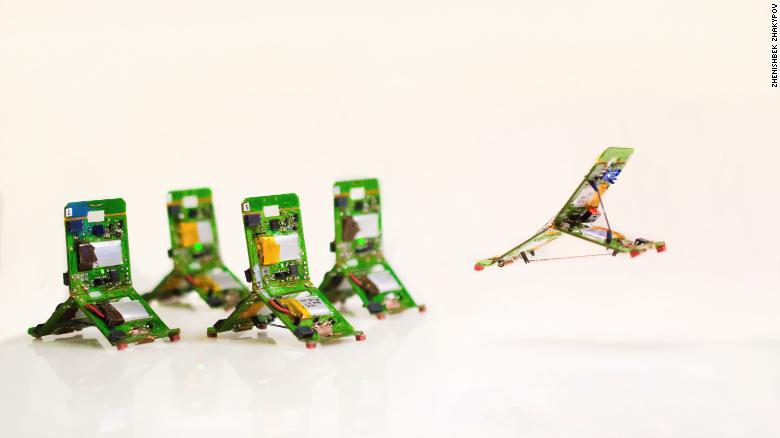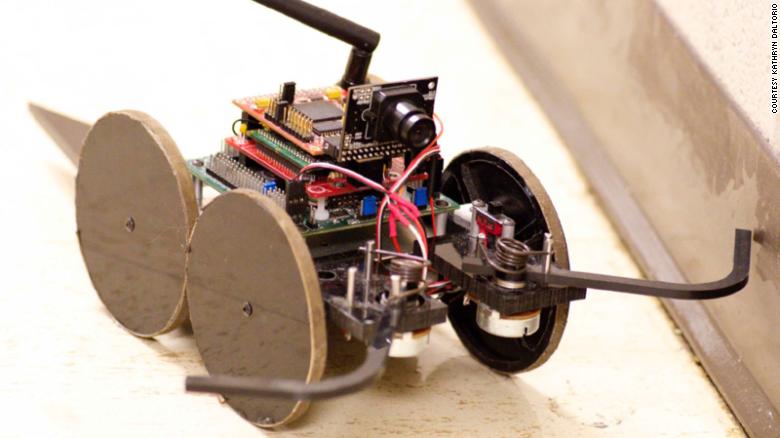以昆虫为灵感的能跳、能飞、能爬的机器人即将问世
以昆虫为灵感的能跳、能飞、能爬的机器人即将问世
A whole arm of robotics is focusing on bug-size 'bots (and smaller).
整个机器人领域都在专注于虫子大小(甚至更小)的机器人。
It's not just the size of tiny insects that are inspiring roboticists; it's also the many complex tasks and physical feats that comprise the everyday lives of many fleas, flies and other six-legged creatures.
不仅是微小昆虫的大小激发机器人专家们的灵感,许多跳蚤、苍蝇和其他六条腿生物的日常生活也包含许多复杂的任务和身体特技。

The question isn't only how big and powerful we can make a machine, but how small and savvy. What might humans be capable of if we could command a tiny army of simple machines? How could we use robots that could fly, skim across the water, hop to the ceiling and even swarm?
问题不仅在于我们能制造出多大、多强大的机器,还在于它有多小、有多聪明。如果我们能指挥一支由简单机器组成的小军队,人类能做些什么呢?我们如何利用能飞、能掠过水面、能跳到天花板上甚至能成群结队的机器人呢?

That's exactly the kind of question roboticists like Zeynep Temel, an assistant professor of robotics at Carnegie Mellon University in Pittsburgh, is asking -- and answering -- in her lab.
这正是像泽伊内普·特梅尔这样的机器人专家在她的实验室里提出和回答的问题。泽伊内普是匹兹堡卡内基梅隆大学的机器人技术助理教授。
Tiny robots would be useful in medical applications -- for targeted drug delivery or simple surgeries sans incisions, according to Temel. Miniature robots could also save lives in dangerous places like minefields, or during search and rescue: "If you have small bug-robots, it's possible to do ‘more efficient -- and safer -- rescue operations’ following an avalanche or earthquake where it's dangerous for humans or even larger robots to tread. " she said.
特梅尔表示,微型机器人将在医疗应用中发挥作用——用于定向输送药物或无切口的简单手术。微型机器人还可以在雷区等危险地点或搜救过程中拯救生命:“如果你有小虫子型机器人,它就有可能在雪崩或地震发生后进行‘更高效、更安全的救援行动’,因为这些地方对人类或更大的机器人来说都很危险。”她说。
Small robots that can work together, like ants or bees do, would also be ideal for exploring other planets like Mars, again keeping humans away from risky, unexplored situations:
能够像蚂蚁或蜜蜂那样协同工作的小型机器人,也将是探索火星等其他行星的理想选择,再次让人类远离危险的、未探索的情况:
"I hope my research will be used to make modular robots that can self-assemble, to be used by astronauts in unknown environments to lend a helping hand," said Jamie Paik, founder and director of the Reconfigurable Robotics Lab at the Swiss Federal Institute of Technology.
瑞士联邦理工学院可重构机器人实验室的创始人兼主任杰米·派克说:“我希望我的研究能用于制造模块化机器人,这种机器人可以自我组装,供宇航员在未知环境下使用并提供帮助。”
These are just some of the important applications bio-inspired robots could be used for, and that's why roboticists at the worldwide major robotics labs are dedicated to exploring the class Insecta.
这些只是仿生机器人可以用于的一些重要应用,这就是为什么世界主要机器人实验室的机器人专家致力于探索昆虫类。
Ants are a favorite inspiration -- they're able to lift bulky and heavier-than-they-are loads and travel quickly in sandy deserts as well as woodlands. These insects also work together to create bridges and surmount obstacles.
蚂蚁是最受欢迎的灵感来源——它们能够举起比自己体积大或重量重的东西,而且在沙漠和林地都能快速移动。这些昆虫还一起工作,创造桥梁,克服障碍。
Why are insects such useful inspiration for roboticists? They give scientists a starting point, Paik said, that proves a possibility -- such as jumping 100 times their height like a flea, climbing vertical obstacles (or even upside down) or packing wings under a petite hard shell like a ladybug. "These are nature's optimized designs," she said.
为什么昆虫对机器人专家来说是如此有用的灵感?他们给了科学家们一个起点,派克说,这证明了一种可能性——比如像跳蚤一样跳跃100倍于他们的高度,攀爬垂直的障碍物(甚至是倒立的),或者像瓢虫一样将翅膀包裹在微小的坚硬外壳下。”这些都是大自然的优化设计,”她说。

Temel backed up Paik's point -- while she said she's still a bit personally afraid of insects (the live ones), she has nonetheless come to admire how well they solve so many difficult problems.
特梅尔支持派克的观点——尽管她说她个人还是有点害怕昆虫(活的),但是她已经开始钦佩昆虫是如何解决这么多难题的。
"They swim, they fly fast and know how to balance to perch, they walk and jump on the water's surface, and they can jump onto leaves which are like tiny, unstable platforms," Temel said.
“它们会游泳,飞得很快,知道如何在栖木上保持平衡,它们在水面上行走和跳跃,它们还能跳到树叶上,树叶就像微小的、不稳定的平台,”特梅尔说。
One of the biggest challenges for robots of all sizes is remaining upright on complex surfaces. "Robots are good at smooth, but natural terrain is fascinatingly rough, and so it's difficult for robots," said Kathryn Daltorio, an assistant professor of mechanical engineering at Case Western Reserve University.
对于所有大小的机器人来说,最大的挑战之一就是在复杂的表面上保持直立。凯斯西储大学机械工程助理教授凯瑟琳·达尔托里奥说:“机器人擅长平滑地形(行动),但自然地形非常粗糙,所以对机器人来说很难适应。”
There is still a lot more research for roboticists to do before robots are as smart and agile as insects: "Even a small fly has really smart reactions that are quick and able to respond to a lot of sensory information," Daltorio said. "(Insects) have this very rich and adaptive behavioral repertoire that we can't yet get a robot to do."
在机器人像昆虫一样聪明敏捷之前,机器人专家还有很多工作要做。达尔托里奥说:“即使是小苍蝇也有非常敏捷的反应,能够对很多感官信息做出快速的反应。”“(昆虫)有这种非常丰富的适应性行为技能,我们还不能让机器人做到这一点。”


















